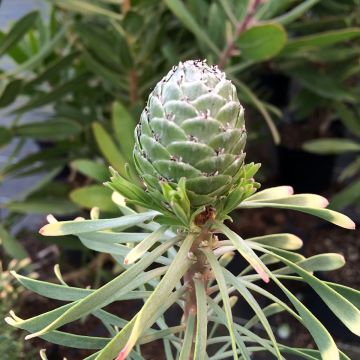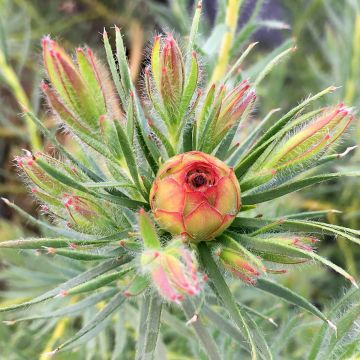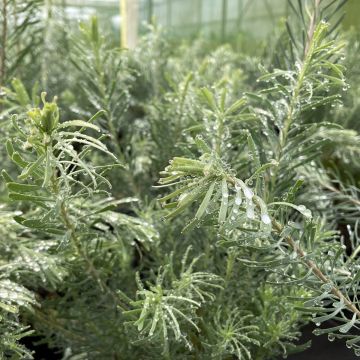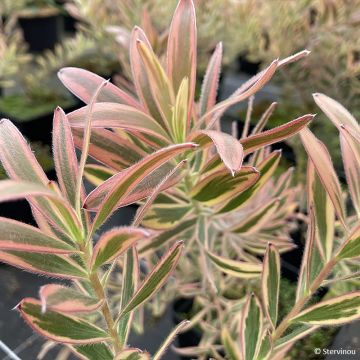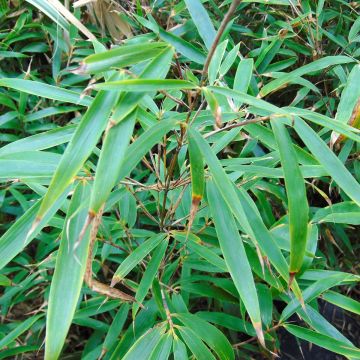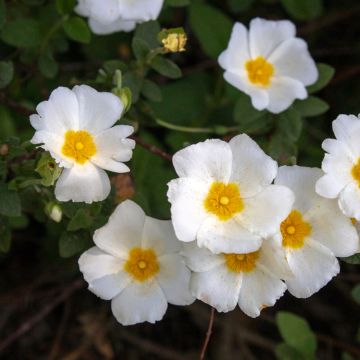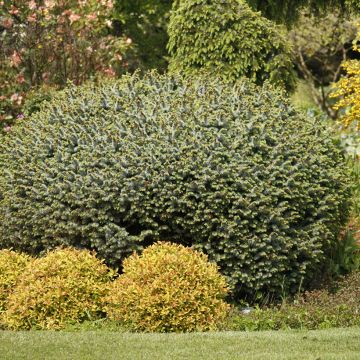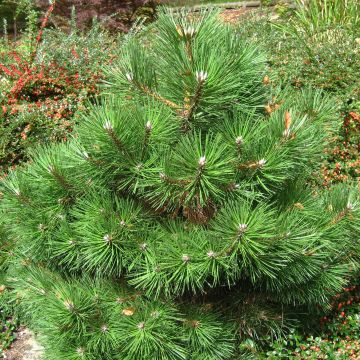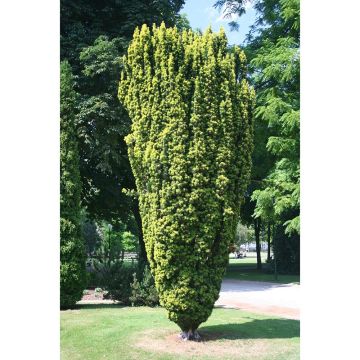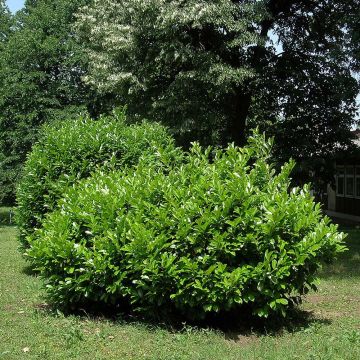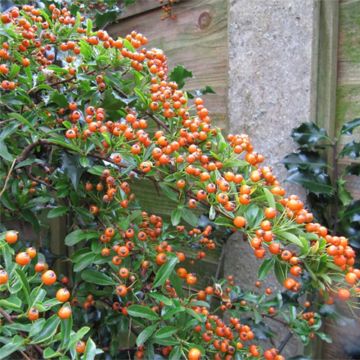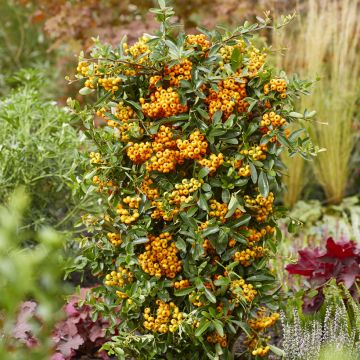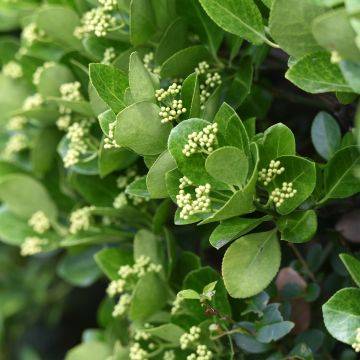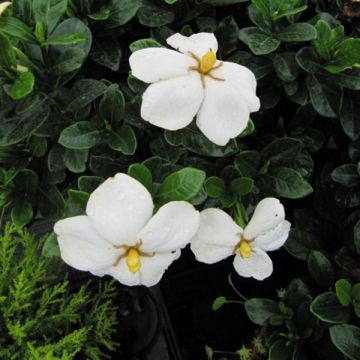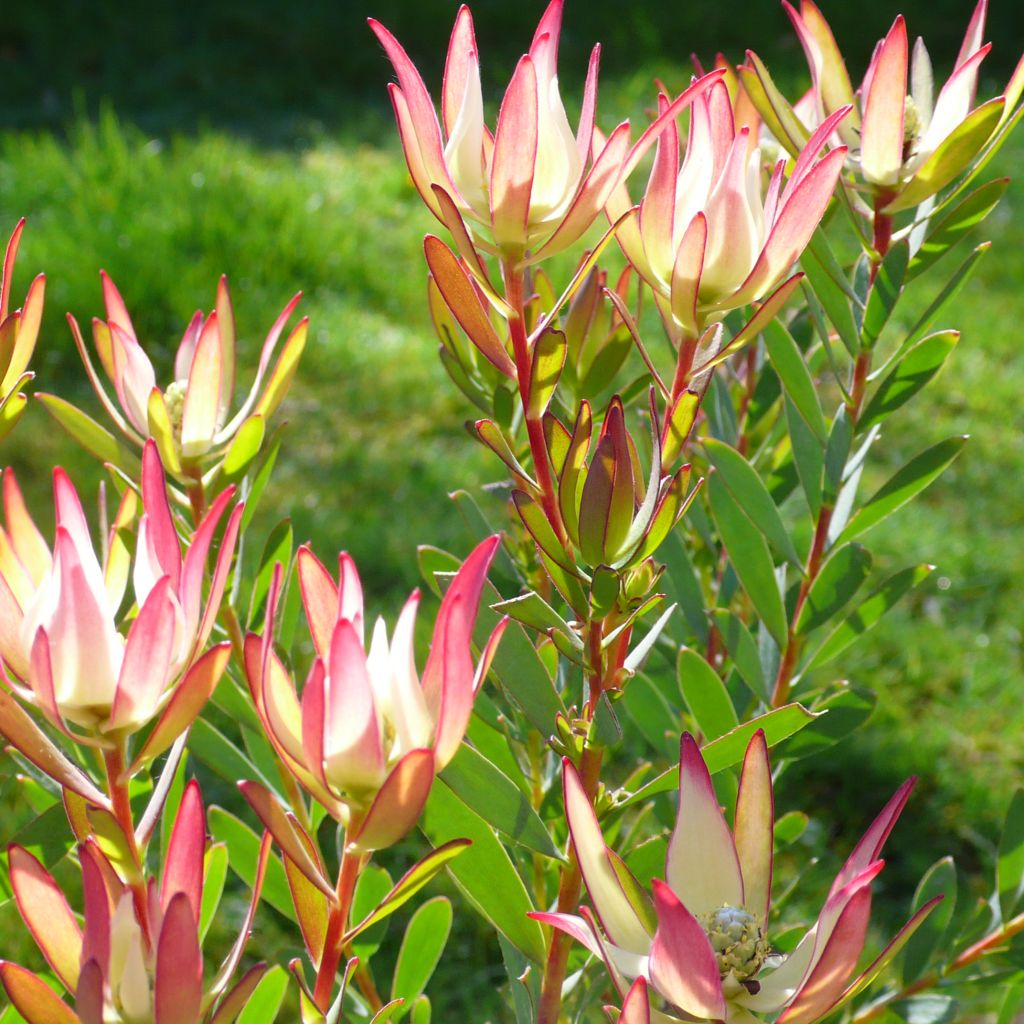

Leucadendron Jack Harre
Leucadendron Jack Harre - Conebush
Leucadendron Jack Harre
Conebush
Hello A beautiful young plant in good health. The packaging is very well done.
Christophe, 17/05/2022
This item cannot be shipped to the selected country
Delivery charge from €5.90
More information
Schedule delivery date,
and select date in basket
This plant carries a 24 months recovery warranty
More information
We guarantee the quality of our plants for a full growing cycle, and will replace at our expense any plant that fails to recover under normal climatic and planting conditions.
From €5.90 for pickup delivery and €6.90 for home delivery
Express home delivery from €8.90.
Does this plant fit my garden?
Set up your Plantfit profile →
Description
Leucadendron 'Jack Harre' is an evergreen and bushy shrub suited to mild climates, rare in cultivation. It is a cousin of Proteas, with which it shares a preference for full sun and dry soils in summer. This selection stands out for beautiful spring flowering which covers its ovate foliage, marked in purple, with pretty pink and red inflorescences that are circled with waxy bracts, like ruffs. It is a plant with very exotic charm, adapted to a Mediterranean climate or for cultivation in large pots under more humid and cooler skies. Its cultivation is sometimes delicate in soil that is too rich, and it prefers a non-alkaline soil.
Leucadendron 'Jack Harre' is a hybrid from Leucadendron salignum, a bush native to the Cape Province in South Africa where Leucadendrons are an essential part of the fynbos ecoregion, a narrow coastal and mountainous zone characterised by a Mediterranean climate. This woody and branching plant is part of the Proteaceae family. The 'Jack Harre' cultivar forms a bush 1m (3 ft) high and wide under favourable conditions. The leaves, single and tough, ovate to elliptical in shape, are light green, clearly spotted with dark red. In May-June the bush produces elliptical floral buds of a red tint at the end of its branches. These bloom into compound inflorescences forming a heart of tiny brownish flowers surrounded by a ruff of pointed, thick and tough bracts, pink, irregularly bordered with red. Leucadendrons are dioecious, meaning that male and female flowers are borne on distinct plants. The female inflorescences are less showy and emit a powerful yeasty smell. The flowers are very popular in floristry because of their excellent vase life.
Leucadendron 'Jack Harre' is a very exotic-looking plant that won't leave you indifferent. Preferably planted in a coastal garden spared from severe frosts, in light soil with an acidic tendency and poor in nitrates and phosphorus. Particularly adapted to the Mediterranean climate, it is content with ungrateful, dry to arid soils, and will look good on its own, on large slopes or in the back of dry garden beds, but always in an open situation, in full sun. In an exotic-themed garden it can be combined with cordylines, proteas, Canary Viperine, Euphorbia characias, Euphorbia mellifera, Great Ferula, Melianthus major, palm trees or Leptospermum. This bush also grows very well in a tub or a large pot, to decorate the terrace or balcony of an experienced gardener.
Report an error about the product description
Leucadendron Jack Harre - Conebush in pictures
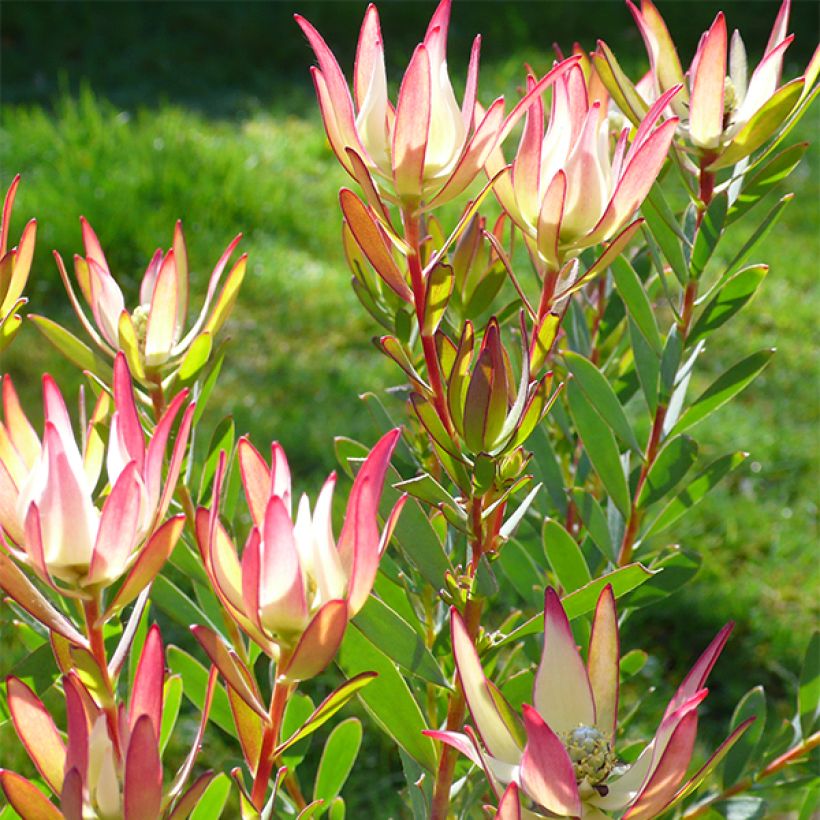

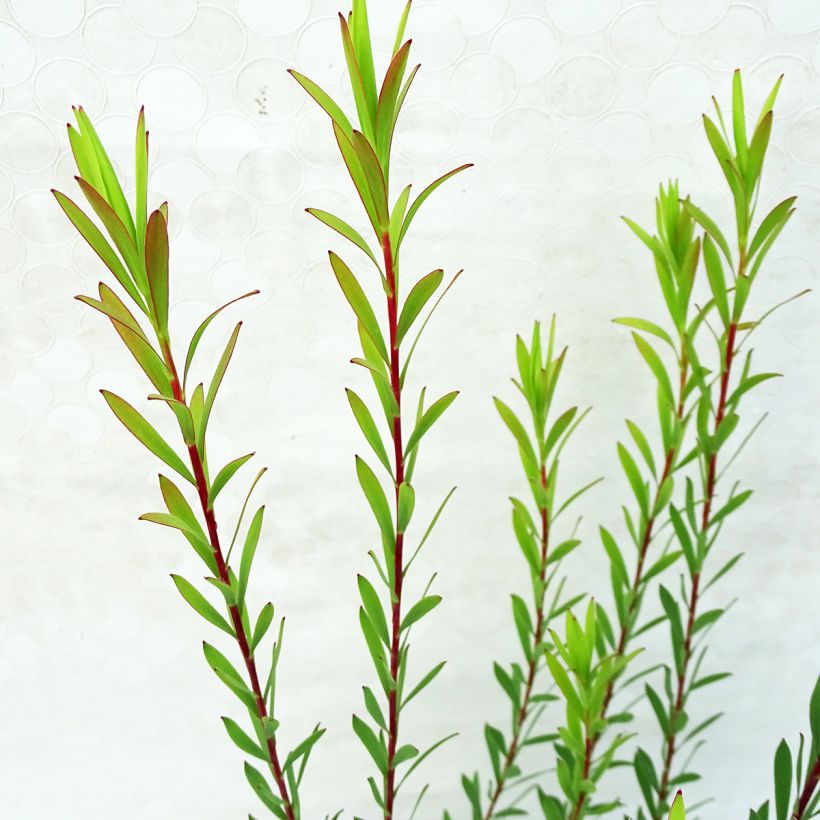

Plant habit
Flowering
Foliage
Botanical data
Leucadendron
Jack Harre
Proteaceae
Conebush
South Africa
Other Leucadendron
Planting and care
Plant Leucadendron Jack Harre in a very sunny site sheltered from cold winds, in soil that is very well drained, even sandy. Immerse the pot for a few minutes in a container full of water before removing the young plant. Dig a wide and deep hole. Place the root ball on a well-draining bed composed of loose and light soil, leaf compost, and sand or non-chalky gravel. Fill in the hole with the same mixture. Water to ensure the soil settles compactly around the roots. This plant dislikes soils that are too rich and moist in summer, but it needs water during the growing period, up to the start of flowering, especially when it is grown in a pot. Do not use fertiliser, or only a specialist Protea supplement that is low in nitrates and phosphates. Perform pruning after flowering to maintain a compact habit. In open ground it is preferable to use mulching rather than weeding as a means of weed prevention, in order to spare the roots.
Planting period
Intended location
Care
-
, onOrder confirmed
Reply from on Promesse de fleurs
Evergreen shrubs
Haven't found what you were looking for?
Hardiness is the lowest winter temperature a plant can endure without suffering serious damage or even dying. However, hardiness is affected by location (a sheltered area, such as a patio), protection (winter cover) and soil type (hardiness is improved by well-drained soil).

Photo Sharing Terms & Conditions
In order to encourage gardeners to interact and share their experiences, Promesse de fleurs offers various media enabling content to be uploaded onto its Site - in particular via the ‘Photo sharing’ module.
The User agrees to refrain from:
- Posting any content that is illegal, prejudicial, insulting, racist, inciteful to hatred, revisionist, contrary to public decency, that infringes on privacy or on the privacy rights of third parties, in particular the publicity rights of persons and goods, intellectual property rights, or the right to privacy.
- Submitting content on behalf of a third party;
- Impersonate the identity of a third party and/or publish any personal information about a third party;
In general, the User undertakes to refrain from any unethical behaviour.
All Content (in particular text, comments, files, images, photos, videos, creative works, etc.), which may be subject to property or intellectual property rights, image or other private rights, shall remain the property of the User, subject to the limited rights granted by the terms of the licence granted by Promesse de fleurs as stated below. Users are at liberty to publish or not to publish such Content on the Site, notably via the ‘Photo Sharing’ facility, and accept that this Content shall be made public and freely accessible, notably on the Internet.
Users further acknowledge, undertake to have ,and guarantee that they hold all necessary rights and permissions to publish such material on the Site, in particular with regard to the legislation in force pertaining to any privacy, property, intellectual property, image, or contractual rights, or rights of any other nature. By publishing such Content on the Site, Users acknowledge accepting full liability as publishers of the Content within the meaning of the law, and grant Promesse de fleurs, free of charge, an inclusive, worldwide licence for the said Content for the entire duration of its publication, including all reproduction, representation, up/downloading, displaying, performing, transmission, and storage rights.
Users also grant permission for their name to be linked to the Content and accept that this link may not always be made available.
By engaging in posting material, Users consent to their Content becoming automatically accessible on the Internet, in particular on other sites and/or blogs and/or web pages of the Promesse de fleurs site, including in particular social pages and the Promesse de fleurs catalogue.
Users may secure the removal of entrusted content free of charge by issuing a simple request via our contact form.
The flowering period indicated on our website applies to countries and regions located in USDA zone 8 (France, the United Kingdom, Ireland, the Netherlands, etc.)
It will vary according to where you live:
- In zones 9 to 10 (Italy, Spain, Greece, etc.), flowering will occur about 2 to 4 weeks earlier.
- In zones 6 to 7 (Germany, Poland, Slovenia, and lower mountainous regions), flowering will be delayed by 2 to 3 weeks.
- In zone 5 (Central Europe, Scandinavia), blooming will be delayed by 3 to 5 weeks.
In temperate climates, pruning of spring-flowering shrubs (forsythia, spireas, etc.) should be done just after flowering.
Pruning of summer-flowering shrubs (Indian Lilac, Perovskia, etc.) can be done in winter or spring.
In cold regions as well as with frost-sensitive plants, avoid pruning too early when severe frosts may still occur.
The planting period indicated on our website applies to countries and regions located in USDA zone 8 (France, United Kingdom, Ireland, Netherlands).
It will vary according to where you live:
- In Mediterranean zones (Marseille, Madrid, Milan, etc.), autumn and winter are the best planting periods.
- In continental zones (Strasbourg, Munich, Vienna, etc.), delay planting by 2 to 3 weeks in spring and bring it forward by 2 to 4 weeks in autumn.
- In mountainous regions (the Alps, Pyrenees, Carpathians, etc.), it is best to plant in late spring (May-June) or late summer (August-September).
The harvesting period indicated on our website applies to countries and regions in USDA zone 8 (France, England, Ireland, the Netherlands).
In colder areas (Scandinavia, Poland, Austria...) fruit and vegetable harvests are likely to be delayed by 3-4 weeks.
In warmer areas (Italy, Spain, Greece, etc.), harvesting will probably take place earlier, depending on weather conditions.
The sowing periods indicated on our website apply to countries and regions within USDA Zone 8 (France, UK, Ireland, Netherlands).
In colder areas (Scandinavia, Poland, Austria...), delay any outdoor sowing by 3-4 weeks, or sow under glass.
In warmer climes (Italy, Spain, Greece, etc.), bring outdoor sowing forward by a few weeks.


































